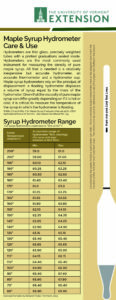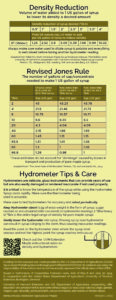Temperature Compensation Chart for Maple Syrup Hydrometers
The University of Vermont Extension’s “New” temperature compensation chart syrup hydrometers. 


Showing 1 – 10 of 13 resources
The University of Vermont Extension’s “New” temperature compensation chart syrup hydrometers. 


This ongoing podcast features interviews with researchers and educators about topics related to maple production and marketing.
An examination of why and how maple sugarmakers can make their operations carbon-neutral.
Over two-thirds of consumers say that living a more sustainable lifestyle is important to them. Eco-friendly and Fair Trade claims are attractive to consumers, but the marketplace is still trying to clarify what lies behind these claims and if shoppers really follow through with their interests in the form of purchases. Consumer sentiment research looked at retail sales from 2017-2020 and showed that consumer spending on products with environmental, social and governance (ESG) claims grew at a faster rate than products without such claims (Am et al., 2023).
This tool is meant to identify off-flavors in syrup, and link the particular sensory experience to a specific defect and category that explains why the defect has occurred. Additionally, this tool serves as a user-friendly representation of the Vermont Agency of Agriculture Farms and Markets (VAAFM) “Maple Syrup Off-Flavors” manual.
The map of maple is a sensory tool, allowing you to explore all the wondrous possibilities of Vermont maple syrup. It offers some hints for tasting on your own.
Business is booming if you own a commercial sugar bush! As forest managers, this means more and more of us are hearing from landowners interested in starting or maintaining a sugar bush. Unfortunately, if you are like us, you did not learn about maple syrup in forestry school. This episode’s guest, Mark Isselhardt, Extension Maple Specialist with the University of Vermont, helps us unpack the fundamentals of sap production, sugar bush management, and how the industry has changed in the 21st century.
Guidelines for tapping maple trees have existed for well over 100 years. Early tapping guidelines came about when buckets (gravity collection) were the only technology available for harvesting sap. New tapping guidelines are based on years of research into maple tree growth, sap harvesting practices/technology and a recognition that tree diameter alone does not fully explain all the factors that determine if tapping intensity in a given sugarbush is sustainable. This fact sheet presents sustainable tapping guidelines.
Without a freeze, the flow of sap will continue to slow and eventually stop because there is no longer a difference between the pressure inside and outside of the tree. However, producers often observe an uptick in sap flow during the daytime over a few days. Why does this occur? Where did the extra sap come from? Typically, these short bursts of increased sap flow happen when the temperature warms over the next few days. The warm temperature causes gas bubbles in the wood fibers to expand and squeeze more water from the wood tissues, where it flows into the vessels and out through the taphole. This might occur for a couple of days, and eventually turn into slow weeping flows before ceasing entirely.
Judged maple syrup contests originated as a friendly competition amongst producers in the early part of the 20th century. More recently, these competitions have evolved into a valuable opportunity for producers to improve their practice and evaluate their production methods. The grading system employed in the judging process facilitates communication about the uniqueness of pure maple syrup. The world standard definitions, uniform grading system, and related guidelines have been developed to promote uniformity throughout the maple industry. In competition, the same standards apply, regardless of where the contest is being held. As maple judging has evolved, so have the guidelines. Every region has contributed to the refinement of these criteria, as the process of judging has become more sophisticated and widespread. Producers throughout the US and Eastern Canada have begun to embrace maple judging as they understand the value of knowing how to make syrup to a high standard. Consumers benefit from the emphasis on taste, and off-flavored syrup is kept out of the market.